-
Notifications
You must be signed in to change notification settings - Fork 233
L2 L3 MEM traffic on Intel Skylake SP CascadeLake SP
Intel introduced with Intel Skylake SP (and the successor Cascadelake SP) a change in the cache hierarchy. The sizes of each layer are changed (L2 larger, L3 smaller) and the L3 is now a victim cache (non-inclusive cache). This results also in a different approach to measure the traffic between L2, L3 and memory.
What is a victim cache
On all architectures before Intel Skylake SP (SKX), like Intel Broadwell EP (BDX), the caches are (mostly?) inclusive. This means that all cache lines that are currently in L1 are contained in L2 and L3 cache as well (same for all lines in L2 that are also present in L3). With Intel Skylake SP, the L3 cache became a victim cache (non-inclusive) while L1 and L2 continue being inclusive.
If a core requests data from memory, it is directly loaded into L2 (and then in L1) bypassing the L3 cache (**). If a cache lines need to be evicted from L2, the current line state is checked and, based on some heuristics which includes probability of reuse and sharing between cores and chips:
- cache line is dropped
- cache line is evicted to L3
- cache line is evicted directly to memory
The exact heuristics are not published by Intel.

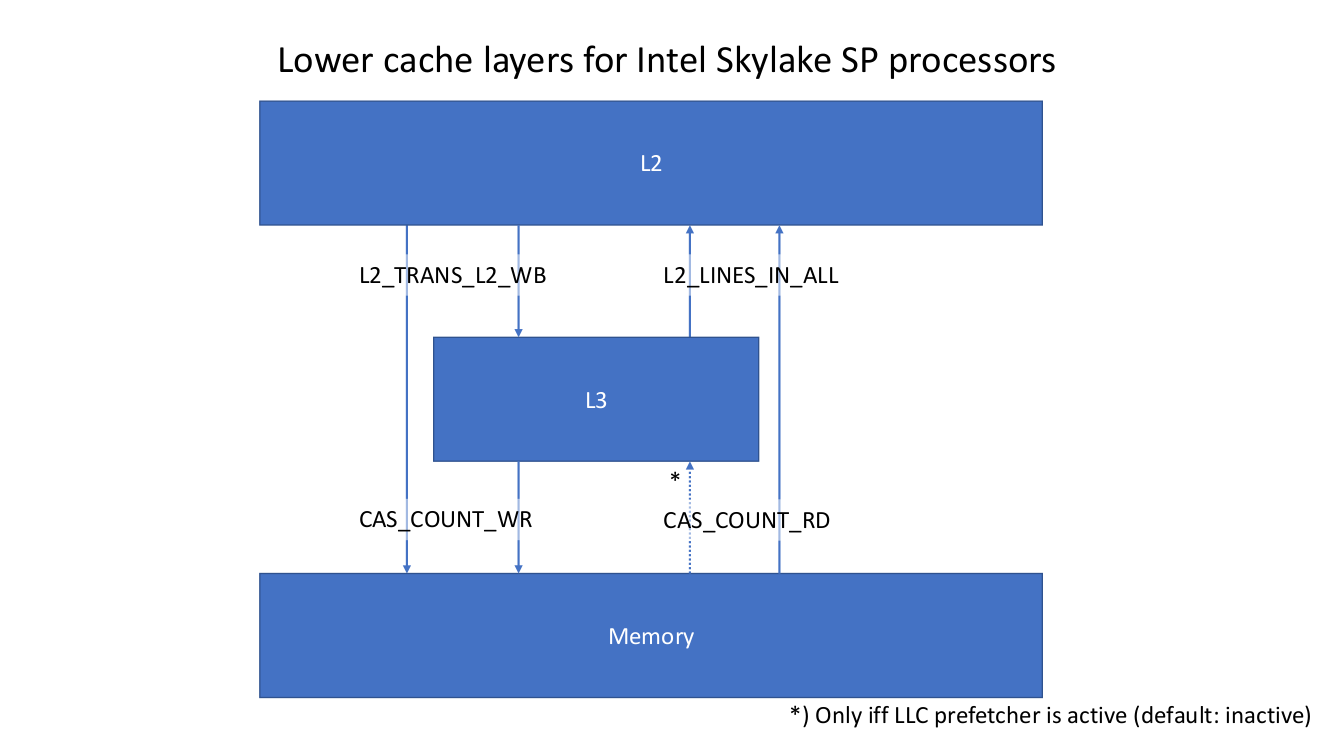
(**) Except the LLC prefetcher is active and pulls some cache lines from memory. Which it is on the Intel Skylake SP test system. But as we see later, the currently known events are not able to differentiate the L2 load traffic between L2 and either L3 or memory. The prefetcher accelerates the loading of data for streaming access, so we probably measure a higher load bandwidth due to the prefetcher but the analysis is based on data volume per iteration leaving out the factor time.
For the CPU architectures before Intel Skylake SP, LIKWID uses two events for loaded (L2_LINES_IN_ALL, rf107, (--)) and evicted (L2_TRANS_L2_WB, r40f0, (++)) cache lines. This was enough to achieve a high accuracy because all data coming from memory and going to memory has to flow through L2 and L3. With Intel Skylake SP the situation changed and the event L2_LINES_IN_ALL is the sum of loads from L3 and memory (simply all cache lines coming into L2 independent of the source). The same behavior is true for the L2_TRANS_L2_WB event. There is no differentiation between evicts to L3 and evicts to memory and also no event for counting dropped cache lines, the event simply counts all cache lines written back by L2 which touch the L2.
(--, ++) For the both architectures: Intel Broadwell EP and Intel Skylake SP.
(++) There are other usable events, like L2_LINES_OUT_SILENT (r01F2) and L2_LINES_OUT_NON_SILENT (r02F2) for Intel Skylake SP.
| Event | BDX | SKX |
|---|---|---|
| L2_LINES_IN_ALL | This event counts the number of L2 cache lines filling the L2. Counting does not cover rejects. | Counts the number of L2 cache lines filling the L2. Counting does not cover rejects. |
| L2_TRANS_L2_WB | This event counts L2 writebacks that access L2 cache. | Counts L2 writebacks that access L2 cache. |
| L2_LINES_OUT_SILENT | - | Counts the number of lines that are silently dropped by L2 cache when triggered by an L2 cache fill. These lines are typically in Shared or Exclusive state. A non-threaded event. |
| L2_LINES_OUT_NON_SILENT | - | Counts the number of lines that are evicted by L2 cache when triggered by an L2 cache fill. Those lines can be either in modified state or clean state. Modified lines may either be written back to L3 or directly written to memory and not allocated in L3. Clean lines may either be allocated in L3 or dropped |
In order to show the difference at hardware level, I took some measurements (LIKWID version 4.3.4) with the current L3 group (BDX, SKX) using a single core on an Intel Broadwell EP (Intel(R) Xeon(R) CPU E5-2697 v4 @ 2.30GHz, CPU clock fixed to 2.30 GHz) and an Intel Skylake SP (Intel(R) Xeon(R) Gold 6148 CPU @ 2.40GHz, CPU clock fixed to 2.40 GHz). As benchmark application I used likwid-bench with the benchmarks:
-
load: register = A[i] -
store: A[i] = constant -
copy: A[i] = B[i] -
stream: A[i] = B[i] * c + C[i] -
triad: A[i] = B[i] * C[i] + D[i]
All benchmarks work on double precision floating-point arrays using scalar operations.
I mentioned that there are different events to measure the evict/writeback traffic from L2, so we test first whether our selection, the L2_TRANS_L2_WB event, provides better/worse results compared to the L2_LINES_OUT_* events.
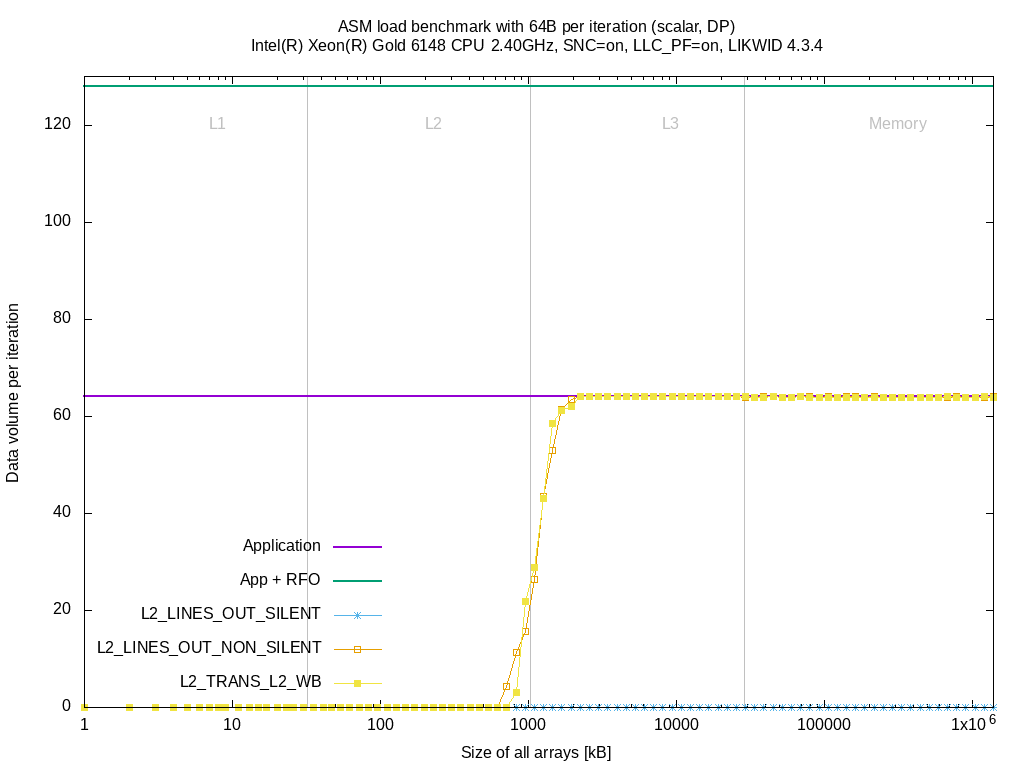
In order to improve visibility, the remaining benchmarks are not directly shown but here are the links:
These plots clearly show no real difference in the measurements of L2_LINES_OUT_NON_SILENT and L2_TRANS_L2_WB under these workloads. The L2_LINES_OUT_SILENT event stays at zero. There might be workloads that produce different pictures. The measurements are performed in two application runs, first the L2_TRANS_L2_WB and second all L2_LINES_OUT_* events.
So let's check full measurements to show the difference between BDX and SKX.
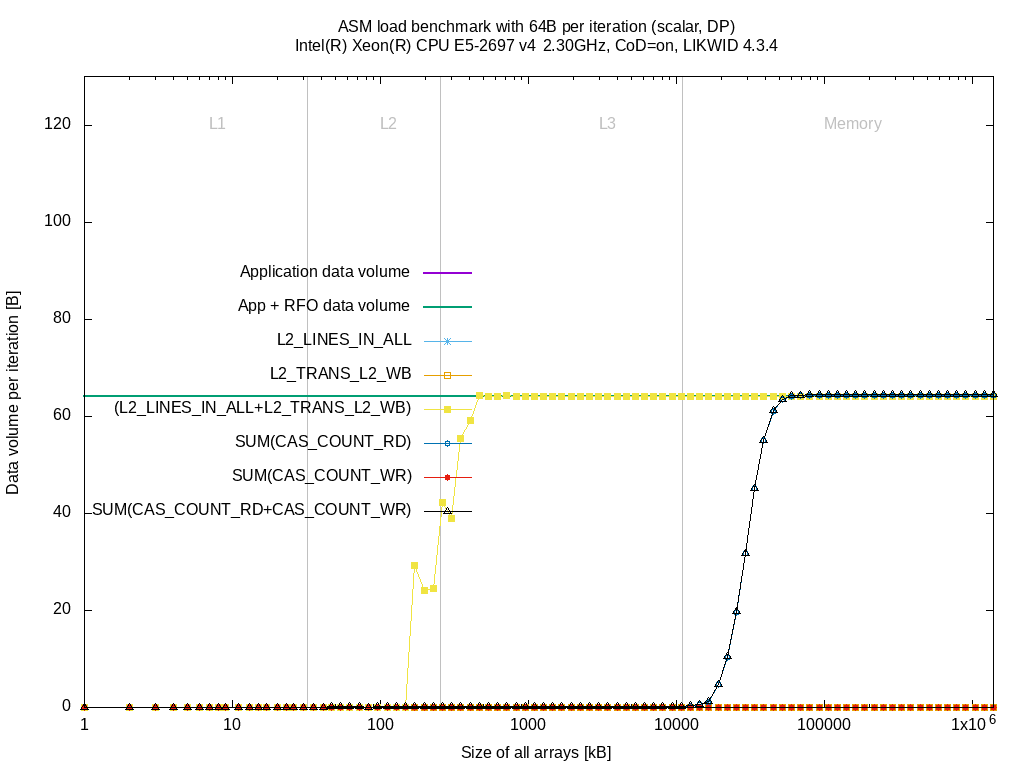
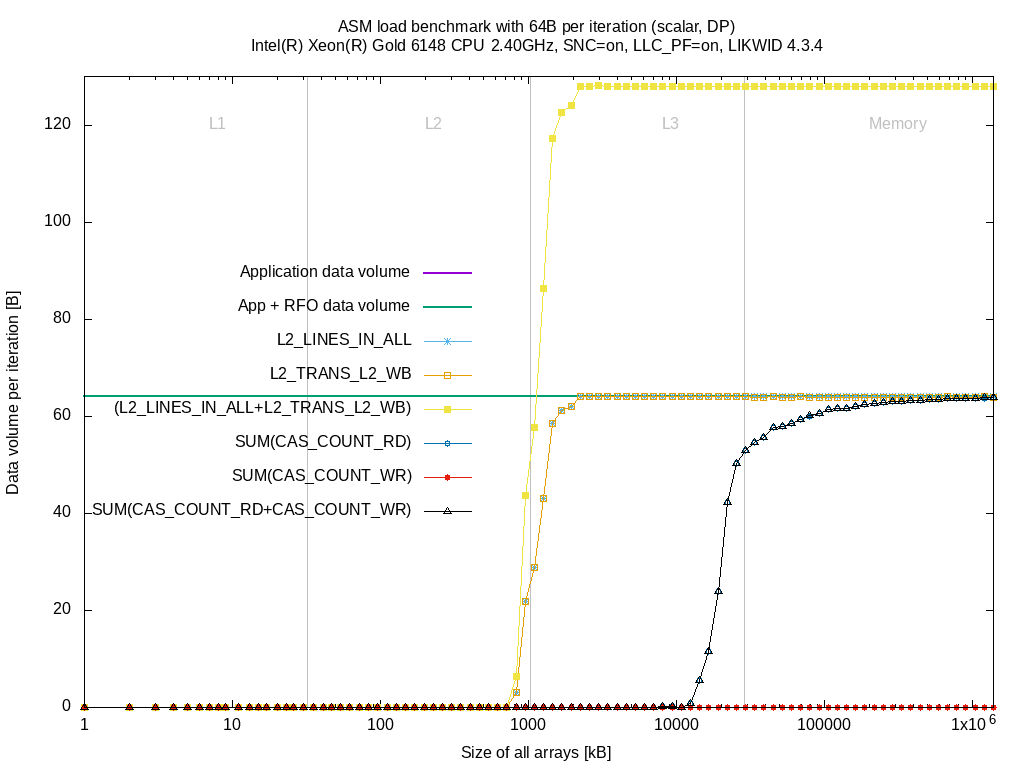
| BDX | SKX |
|---|---|
As soon as the data sizes fill the L2 cache almost completely, the bytes loaded from L3 (L2_LINES_IN_ALLr) raises until it reaches the 64 Byte per iteration. |
When the L2 cache is almost full, the data is loaded from L3 (L2_LINES_IN_ALL) until we read 64 Byte per iteration. Same as for BDX. |
The benchmark does not evict any data, hence the L2_TRANS_L2_WB event stays zero |
L2_TRANS_L2_WB raises similar to (L2_LINES_IN_ALL). This is because the cache lines are evicted from L2 but they can be either evicted to L3, evicted to memory or being dropped. |
When the data sizes come closer to the L3 size (11 MByte as Cluster-on-Die is enabled), the data fetched from memory SUM(CAS_COUNT_RD) increases until 64 Byte |
When the data sizes come closer to the L3 size (full 28 MByte usable although SNC is enabled), the data fetched from memory SUM(CAS_COUNT_RD) increases until 64 Byte. |
SUM(CAS_COUNT_WR) stays zero |
SUM(CAS_COUNT_WR) stays zero |
The problem gets visible here already. Since the L2 cache lines are not commonly contained in the L3, the cache lines need to be moved from L2 to L3 which doubles (for the load benchmark) the measured writeback data volume. Moreover, due to the behavior of the event L2_TRANS_L2_WB counting anything that is being written back passing L2, it is unclear what happens with the cache lines: evict to L3, evict to memory or dropping.
For completeness, here are the plots for the other benchmarks:
| Benchmark | BDX | SKX |
|---|---|---|
| store | link | link |
| copy | link | link |
| stream | link | link |
| triad | link | link |
The L3 performance group for Intel Skylake still uses the two events mentioned above. So, keep in mind that L2_LINES_IN_ALL contains loads from L3 and memory and L2_TRANS_L2_WB contains writebacks to L3 (and memory).
I posted the question in the Intel developer forums and it's not only me/LIKWID having that problem. Others have also tried different events (also in the LLC units, CBOX). At the current state, the events for traffic in and out of L2 do not allow a differentiation of the source resp. destination.
The memory traffic can be measured properly and with high accuracy assuming 64B for each read and write operation to memory. But the memory controllers are located in the Uncore part of the CPU and thus the counts reflect the traffic to/from all cores of a socket (+ intersocket traffic)
It is probably possible to use L3 events (part of the Uncore) to retrieve the counts for data flowing into L3, data being loaded by the L2 and the evictions to memory. But the Uncore is socket-specific and consequently does not allow the attribution of a single cores' data consumption. Furthermore, there are quite a few LLC units (CBOXes) and each unit has to be programmed and read.
After a meeting with Intel, we got a list of events:
- MEM_INST_RETIRED.ALL_LOADS (r81d0)
- MEM_INST_RETIRED.ALL_STORES (r82d0)
- MEM_LOAD_L3_HIT_RETIRED.XSNP_HIT (r02d2)
- MEM_LOAD_L3_HIT_RETIRED.XSNP_HITM (r04d2)
- MEM_LOAD_L3_HIT_RETIRED.XSNP_MISS (r01d2)
- MEM_LOAD_L3_HIT_RETIRED.XSNP_NONE (r08d2)
- MEM_LOAD_L3_MISS_RETIRED.LOCAL_DRAM (r01d3)
- MEM_LOAD_L3_MISS_RETIRED.REMOTE_DRAM (r02d3)
- MEM_LOAD_L3_MISS_RETIRED.REMOTE_L4 (**)
- MEM_LOAD_MISC_RETIRED.NON_DRAM (**)
- MEM_LOAD_MISC_RETIRED.UC (r04d4)
- MEM_LOAD_MISC_RETIRED.UNKNOWN_SOURCE (**)
All events marked with (**) are not published and consequently not usable by LIKWID. We tried the other events but for some it was clear that it wouldn't work. E.g. the MEM_INST_RETIRED.ALL_* events count the number of loads resp. stores that are issued, executed and retired (completed) by the core, hence some units away from L2, L3 and memory. Moreover, there are cases where an instruction triggers data movement in the background (e.g. read-for-ownership for stores where the destination cache line is not present in the L1 cache) which are not covered by these two events.
I did the same measurements as above on the Skylake SP system. I left out the MEM_INST_RETIRED.ALL_* events and combined all MEM_LOAD_L3_HIT_RETIRED.XSNP_* to a single event MEM_LOAD_L3_HIT_RETIRED.XSNP_ALL.
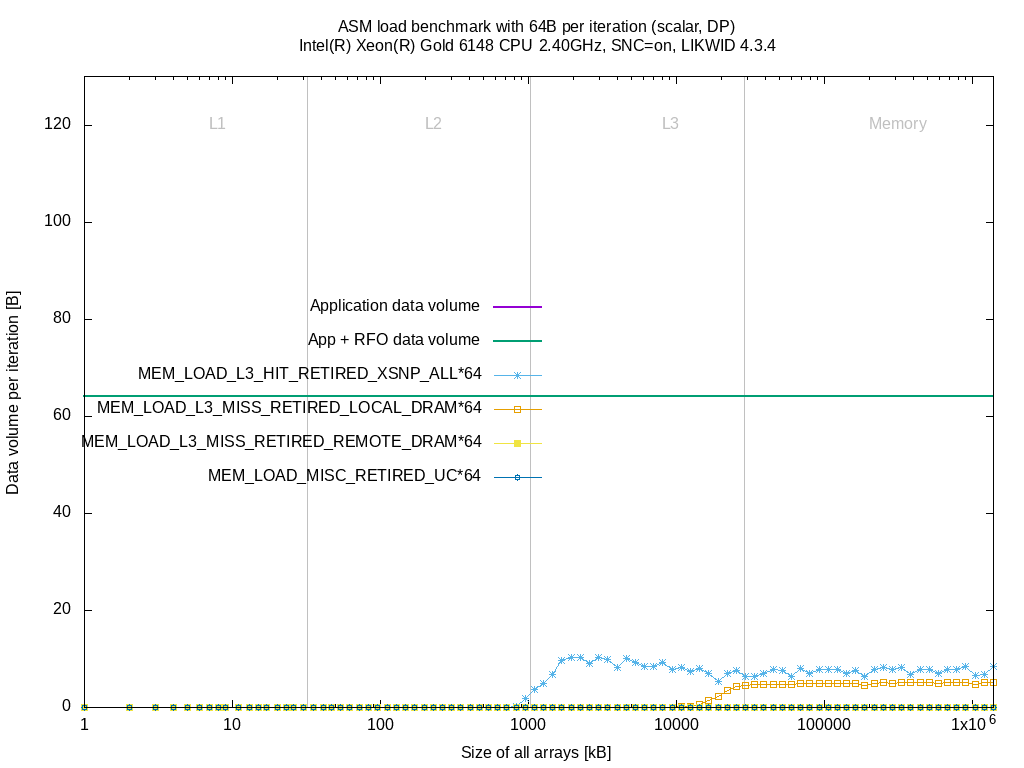
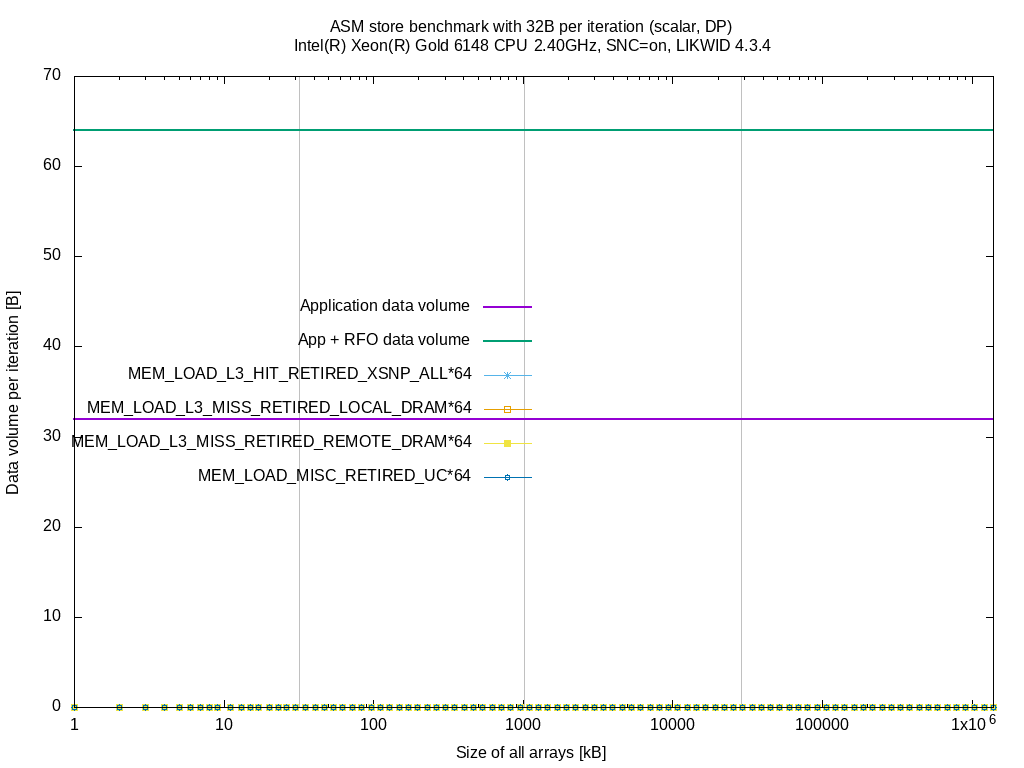
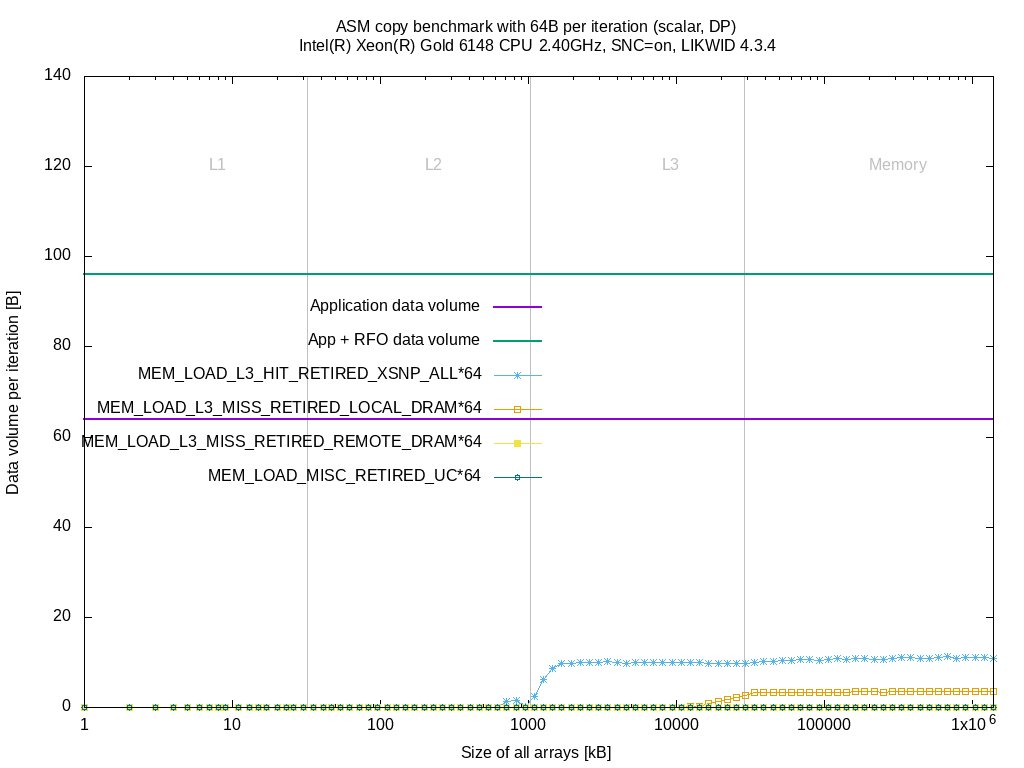
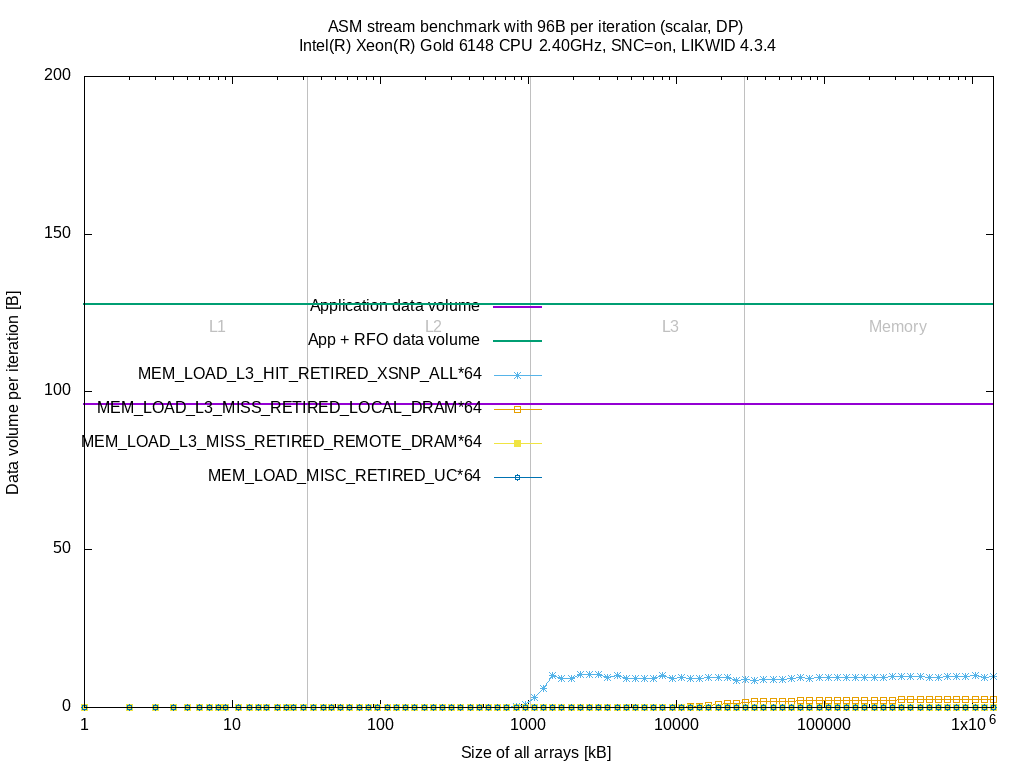
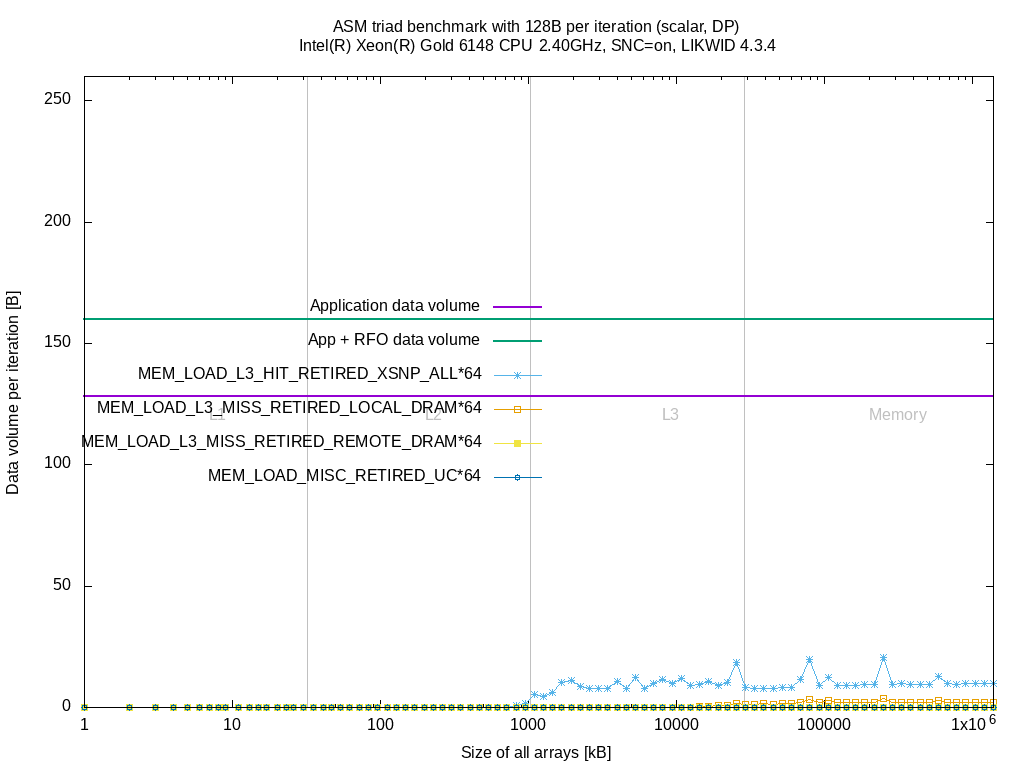
These events don't provide any further insight. The counts raise for some benchmarks when sizes fit in L3 or memory but it's hard to find a relation between these events and the application model (data volume per iteration).
When releasing the Intel Cascadelake SP/AP chips, Intel published two new events IDI_MISC.WB_UPGRADE (Description: Counts number of cache lines that are allocated and written back to L3 with the intention that they are more likely to be reused shortly) and IDI_MISC.WB_DOWNGRADE (Description: Counts number of cache lines that are dropped and not written back to L3 as they are deemed to be less likely to be reused shortly). Whole list of Cascadelake SP/AP events here. One of the problems is, that these events are already mentioned in the errata section of the specification update document for Intel Cascadelake SP/AP:
CLX3. IDI_MISC Performance Monitoring Events May be Inaccurate
Problem: The IDI_MISC.WB_UPGRADE and IDI_MISC.WB_DOWNGRADE performance monitoring events (Event FEH; UMask 02H and 04H) counts cache lines evicted fromthe L2 cache. Due to this erratum, the per logical processor count may be incorrect when both logical processors on the same physical core are active. The aggregate count of both logical processors is not affected by this erratum.
Implication: IDI_MISC performance monitoring events may be inaccurate.
Workaround: None identified.
Status:No fix.
The Intel Cascadelake SP micro architecture is the follow-up to Intel Skylake SP. As an experiment I added the two events to the Intel Skylake SP event file and ran some benchmarks using a single core to get accurate results. Same configuration as in the above comparison between Intel Broadwell EP and Intel Skylake SP.
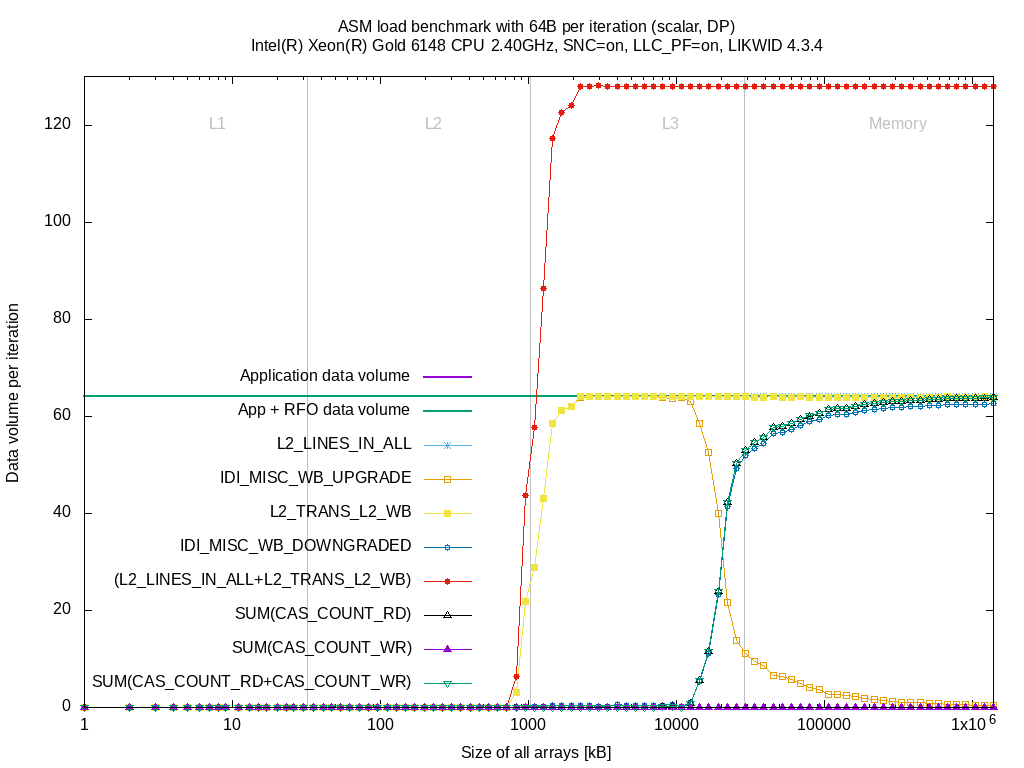
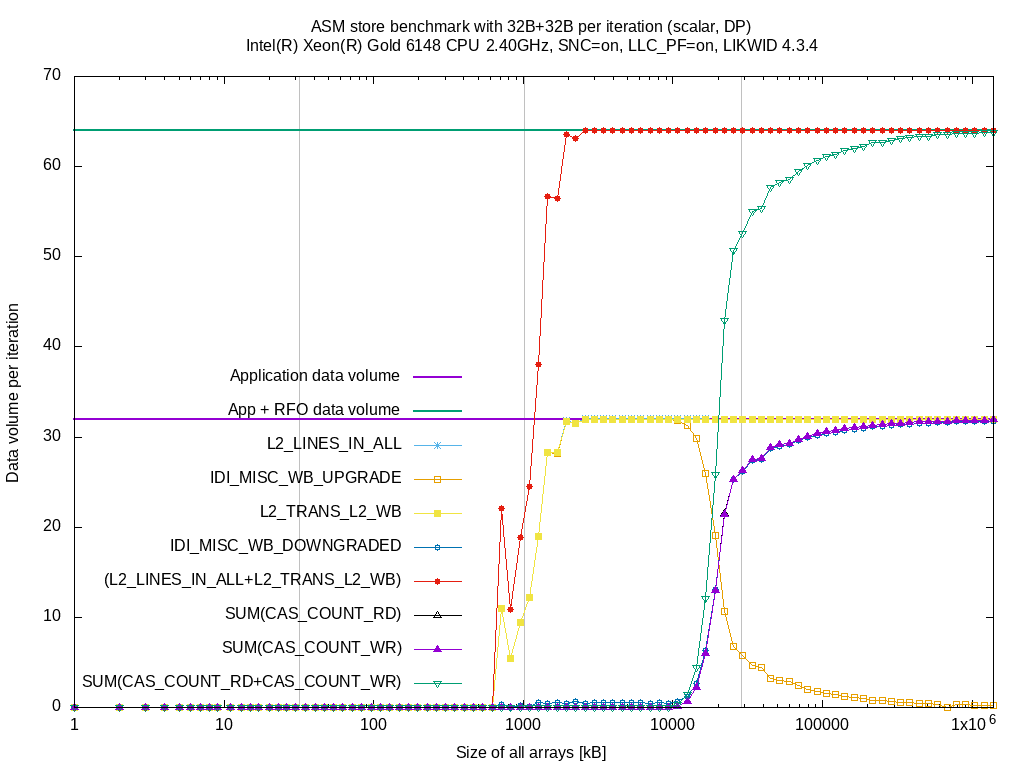
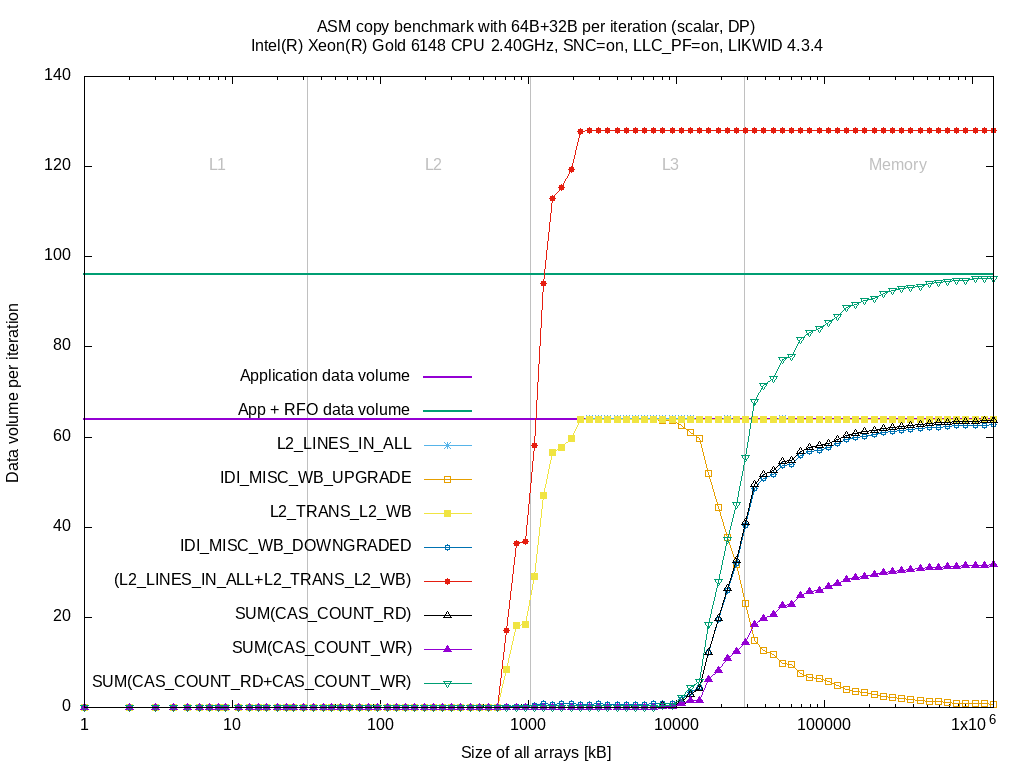
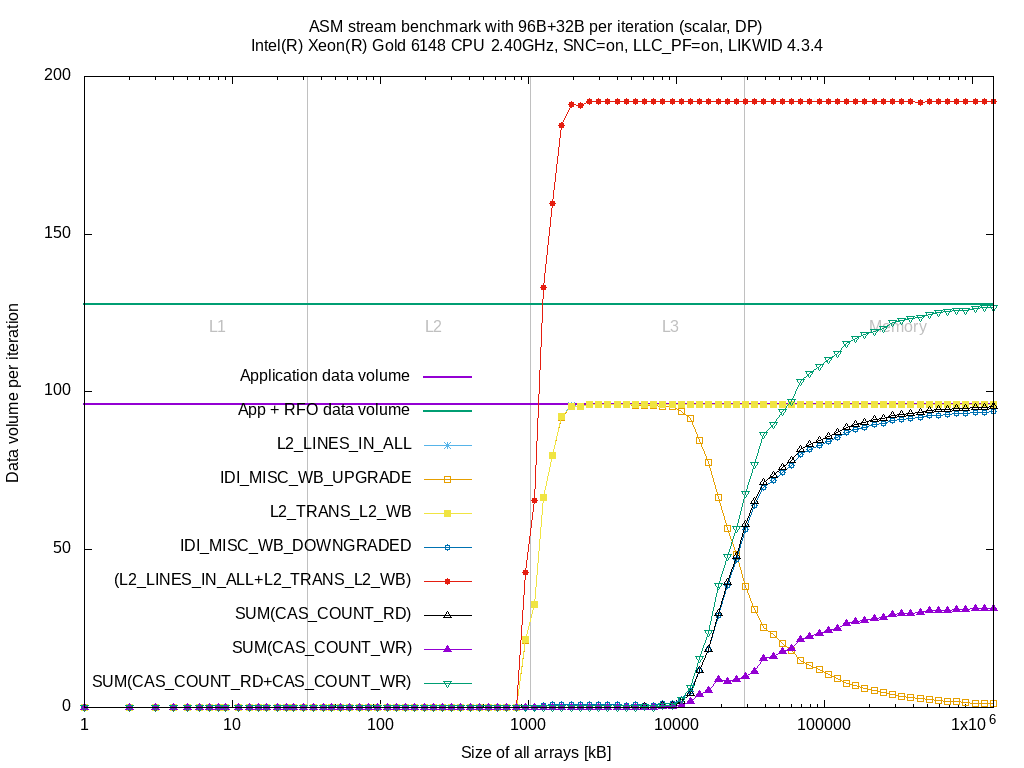
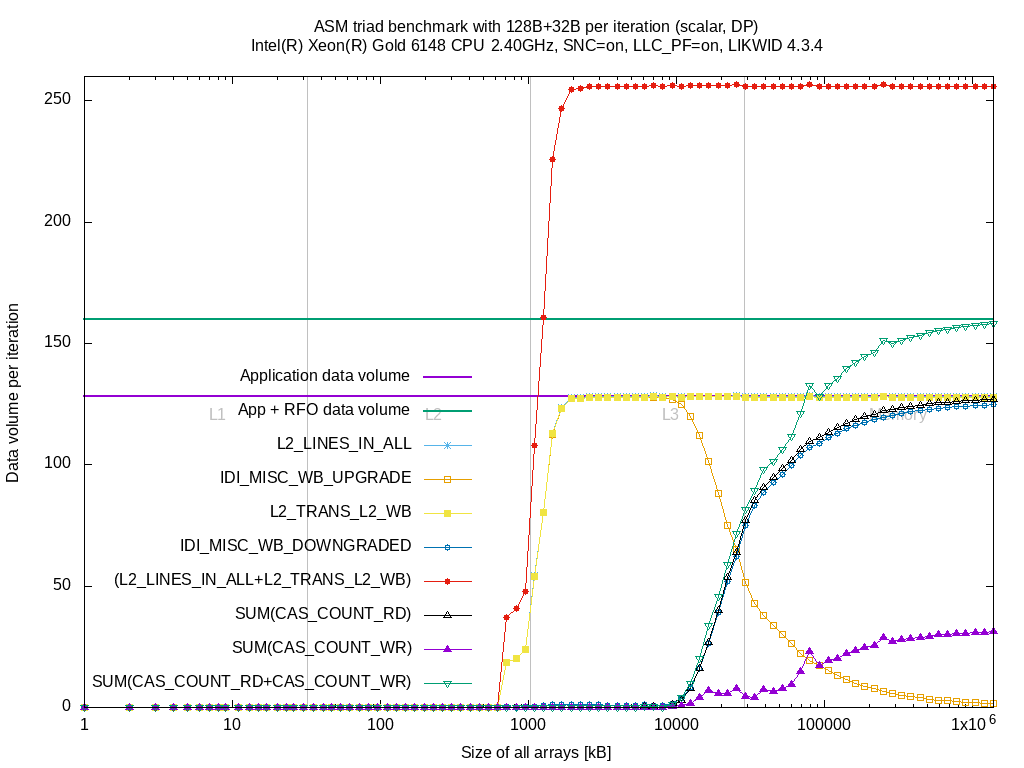
The doubled data volume compared to Intel Broadwell EP is still there but that's expected because the active copy to L3 is required to benefit from the L3 cache. The event IDI_MISC_WB_UPGRADE raises similar to the L2_TRANS_L2_WB event when sizes reach full L2 size. At about 75% of the L3 size, the evictions to L3 due to reuse hint (IDI_MISC_WB_UPGRADE) decrease and cache lines drops raise (IDI_MISC_WB_DOWNGRADE). Similar to the drops, the reads from memory increase as, after dropping, the L2 has to re-read the cache lines from memory.
So for accurate measurements of the writeback path, you need to measure IDI_MISC_WB_UPGRADE and IDI_MISC_WB_DOWNGRADE instead of L2_TRANS_L2_WB.
The results show:
- The events work for Intel Skylake SP although released only for Intel Cascadelake SP
- The L2 writeback path can be characterized. No information about L3 writebacks.
- No information about the load path (##)
So, if we leave out the L2_TRANS_L2_WB from the L3 performance group, we can include both IDI_MISC_WB* events and still have one counter register left. In this counter we could measure the L3 hits to characterize the load path. Unfortunately, the MEM_LOAD_L3_* are likely to be listed in the specification updates. This is not the case for Intel Skylake SP but for Intel Skylake Desktop (SKL128).
(##) Commonly, all data should be loaded from memory directly to L2 except the LLC prefetcher is active (like in this case). One might assume that all cache lines evicted to L3 for re-use are also loaded again from L3 but that would mean that the heuristics are always the optimal decision.
-
Applications
-
Config files
-
Daemons
-
Architectures
- Available counter options
- AMD
- Intel
- Intel Atom
- Intel Pentium M
- Intel Core2
- Intel Nehalem
- Intel NehalemEX
- Intel Westmere
- Intel WestmereEX
- Intel Xeon Phi (KNC)
- Intel Silvermont & Airmont
- Intel Goldmont
- Intel SandyBridge
- Intel SandyBridge EP/EN
- Intel IvyBridge
- Intel IvyBridge EP/EN/EX
- Intel Haswell
- Intel Haswell EP/EN/EX
- Intel Broadwell
- Intel Broadwell D
- Intel Broadwell EP
- Intel Skylake
- Intel Coffeelake
- Intel Kabylake
- Intel Xeon Phi (KNL)
- Intel Skylake X
- Intel Cascadelake SP/AP
- Intel Tigerlake
- Intel Icelake
- Intel Icelake X
- Intel SappireRapids
- Intel GraniteRapids
- Intel SierraForrest
- ARM
- POWER
-
Tutorials
-
Miscellaneous
-
Contributing